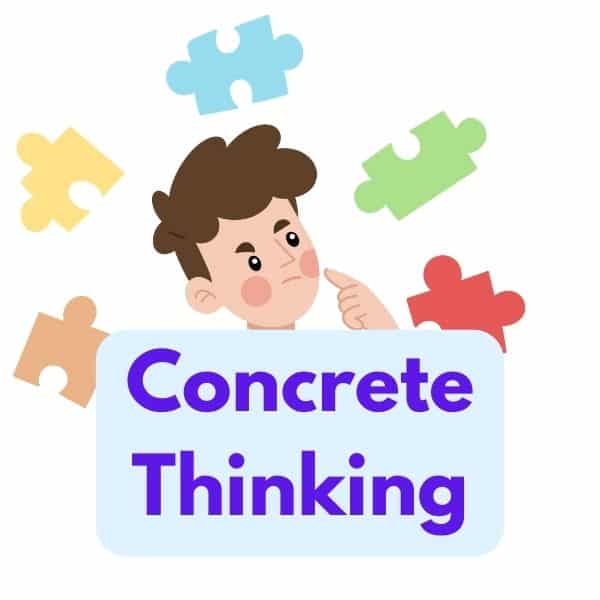Concrete thinking is a type of thinking that focuses on physical objects, immediate experiences, and exact interpretations of the world. It is sometimes called literal thinking because it does not involve abstract concepts, generalizations, or metaphors. Concrete thinking is based on what we can see, hear, feel, and experience in the here and now.
Concrete Thinking Examples
Here are some concrete thinking examples:
- A concrete thinker sees a red apple and thinks of it as a red apple, not as a fruit, food, or a symbol of knowledge.
- A concrete thinker hears the phrase “it’s raining cats and dogs” and thinks of actual animals falling from the sky, not of a heavy downpour.
- A concrete thinker feels a headache and thinks of it as a physical pain in their head, not as a possible sign of stress, dehydration, or illness.
- A concrete thinker smells a rose and thinks of it as a pleasant scent, not as a gesture of love, appreciation, or apology.
- A concrete thinker tastes a lemon and thinks of it as a sour fruit, not as a metaphor for bitterness, freshness, or zest.
- A concrete thinker touches a hot stove and thinks of it as a dangerous object, not as a lesson, a consequence, or a warning.
How Concrete Thinking Develops
Concrete thinking is a natural and necessary part of the learning process. According to the famous psychologist Jean Piaget, children go through different stages of cognitive development, from birth to adolescence, during which they gradually move from concrete to abstract thinking.
- From birth to about 2 years old, babies and toddlers think in terms of what they can observe. They learn through their five senses and do not have object permanence, which means they do not understand that things exist even when they are out of sight.
- From about 2 to 7 years old, children start to think symbolically. They use words, gestures, and images to represent their thoughts and desires. They also begin to reason and predict, but they are still limited by their egocentrism, which means they have difficulty taking other perspectives into account.
- From about 7 to 11 years old, children rely heavily on concrete thinking, but they also develop the ability to understand other people’s feelings and motives. They can perform logical operations on concrete objects and situations, such as adding, subtracting, classifying, and ordering. However, they still struggle with abstract ideas, such as hypothetical scenarios, moral principles, or algebra.
- From about 12 years old onwards, children gradually develop the capacity to analyze, generalize, empathize, and think philosophically. They can use abstract reasoning to solve problems that involve variables, probabilities, or multiple perspectives. They can also reflect on their own thinking processes and evaluate their own beliefs.
Why Concrete Thinking Matters
Concrete thinking is not a sign of low intelligence or a lack of creativity. In fact, concrete thinking has many advantages and benefits for learning and living.
- Concrete thinking helps us to perceive and appreciate the details and nuances of reality. It allows us to notice the colors, shapes, textures, sounds, smells, and tastes of our surroundings. It also helps us to remember facts and events more vividly and accurately.
- Concrete thinking helps us to communicate clearly and effectively. It enables us to express our thoughts and feelings using specific examples and evidence. It also helps us to understand others’ messages by paying attention to their words and actions.
- Concrete thinking helps us to perform practical tasks and activities. It enables us to follow instructions, rules, and procedures without confusion or ambiguity. It also helps us to apply our knowledge and skills to concrete situations and problems.
Limitations of Concrete Thinking
However, concrete thinking also has some limitations and disadvantages that can hinder our learning and living.
- Concrete thinking can make us miss the bigger picture and the deeper meaning of reality. It can prevent us from seeing the connections, patterns, trends, and implications of our observations. It can also limit our imagination and creativity by restricting us to what is already known or given.
- Concrete thinking can make us misunderstand or misinterpret others’ messages. It can cause us to take things too literally or personally without considering the context or intention. It can also make us resistant to new or different ideas that challenge our assumptions or beliefs.
- Concrete thinking can make us struggle with complex tasks and activities. It can hinder our ability to deal with abstract concepts, such as numbers, symbols, logic, or ethics. It can also impair our ability to adapt to changing situations and problems that require flexibility and innovation.
Therefore, concrete thinking is not better or worse than abstract thinking. Rather, it is a complementary mode of thinking that we need to balance with abstract thinking in order to learn and live effectively.
Differences Between Concrete Thinking Vs Abstract Thinking
Here are the differences between concrete thinking and abstract thinking:
| Concrete Thinking | Abstract Thinking |
|---|---|
| Focuses on literal interpretations of language | Focuses on figurative interpretations of language |
| Prefers tangible, observable, and concrete experiences | Prefers intangible, non-observable, and abstract experiences |
| Relies on direct sensory experience | Relies on logic, reasoning, and imagination |
| Struggles with hypothetical situations | Enjoys exploring hypothetical situations |
| Struggles with metaphors and idioms | Enjoys exploring metaphors and idioms |
| Has difficulty understanding abstract concepts such as love or justice | Enjoys exploring abstract concepts |
| Prefers routines and schedules | Enjoys exploring novel and unpredictable experiences |
| Struggles with humor that relies on wordplay | Enjoys humor that relies on wordplay |
| Has difficulty with creative problem-solving | Enjoys creative problem-solving |
| May struggle with complex ideas or tasks | Enjoys exploring complex ideas or tasks |
How It Affects Schizophrenia and Autism
It can also be associated with certain psychiatric disorders, including schizophrenia and autism.
Concrete Thinking in Schizophrenia
In schizophrenia, concrete thinking may be a symptom of formal thought disorder, which is characterized by disorganized thinking and speech. Individuals with schizophrenia may struggle to make abstract connections between concepts or may experience language disturbances that make it difficult for them to understand metaphors and idioms.
Concrete Thinking in Autism
In autism, concrete thinking is a hallmark of the disorder and can contribute to difficulties with social communication and interaction. Individuals with autism may struggle to understand sarcasm, humor, or abstract language and may prefer routines and predictable experiences.
How To Improve Your Concrete Thinking
Concrete thinking is a skill that we can improve with practice and feedback. Here are some tips on how to enhance your concrete thinking abilities:
- Observe your environment carefully and attentively. Try to notice the details and features of the objects and events around you. Describe them using precise words and phrases.
- Practice your sensory skills regularly. Engage in activities that stimulate your five senses, such as painting, cooking, listening to music, gardening, or aromatherapy. Pay attention to how each sense affects your mood and cognition.
- Use concrete examples and evidence to support your arguments and opinions. When you make a claim or a statement, back it up with facts, data, or personal experiences. Avoid vague or general terms that can be interpreted in different ways.
- Ask for clarification and feedback when you communicate with others. If you are not sure what someone means or wants, ask them to explain or demonstrate. If you receive feedback on your work or performance, ask for specific suggestions on how to improve.
- Challenge yourself to learn new and complex concepts and skills. Seek out opportunities to expand your knowledge and abilities in areas that interest you or are relevant to your goals. Use concrete strategies to help you understand and remember abstract information, such as diagrams, mnemonics, analogies, or stories.
Concrete thinking is a valuable and essential mode of thinking that we all use and need. By improving your concrete thinking skills, you can enhance your learning and living in many ways.
FAQs
Q: What is concrete thinking?
A: Concrete thinking is a type of thinking that focuses on physical objects, immediate experiences, and exact interpretations of the world. It is based on what we can see, hear, feel, and experience in the here and now.
Q: How does concrete thinking develop?
A: Concrete thinking develops through different stages of cognitive development, from birth to adolescence, during which children gradually move from concrete to abstract thinking.
Q: What are the advantages and disadvantages of concrete thinking?
A: Concrete thinking has many advantages, such as helping us to perceive and appreciate reality, communicate clearly and effectively, and perform practical tasks and activities. However, it also has some disadvantages, such as making us miss the bigger picture and the deeper meaning of reality, misunderstanding or misinterpreting others’ messages, and struggling with complex tasks and activities.
Q: How can I improve my concrete thinking skills?
A: You can improve your concrete thinking skills by observing your environment carefully and attentively, practicing your sensory skills regularly, using concrete examples and evidence to support your arguments and opinions, asking for clarification and feedback when you communicate with others, and challenging yourself to learn new and complex concepts and skills.
Latest Posts
- Premenstrual Syndrome (PMS) Explained: Powerful Relief Strategies for 2026

- Magnetic Seizure Therapy (MST): A Breakthrough in Psychiatric Treatment in 2025

- AIIMS New Delhi, NIMHANS Bengaluru, JIPMER Puducherry: No Leaves for Healthcare Workers Amid Tensions

- Narcissistic Personality Disorder in 2025: Unveiling the Hidden Struggles and Empowering Recovery

- Conquering Rubral Tremor: Unveiling Effective Treatments in 2025

